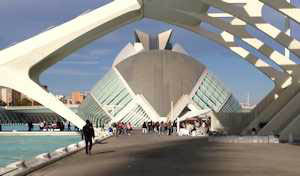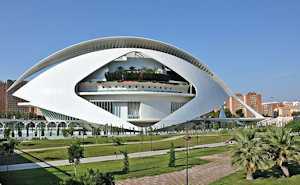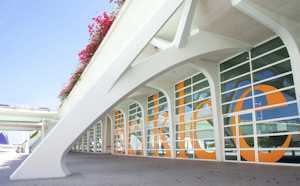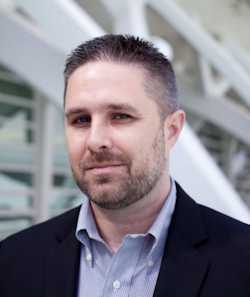 If you are a Star Trek fan, you can easily visualize this: A fleet of Klingon star ships decloaking and landing in a dry riverbed in the middle of a beautiful city. Because, to my eye at least, that is just what the City of Arts and Sciences in Valencia, Spain looks like (the star ships are benign, of course!). It is the most modernist architectural development I have seen anywhere, and rivals the skyscraper monoliths of Shanghai or the Gehry art museum in Bilbao. This City of the Arts and Sciences contains several buildings: a Planetarium, Science Museum, Botanical Garden, the largest Oceanographic Park in Europe, and the Palau de les Arts Reina Sofia. The complex is surrounded by a most imaginative park frequented by families and children, created from the dry bed of the redirected Turia River, with a plaza for open air concerts and reflective water features. It is stunningly beautiful. (This modernist city formed the backdrop for the recent Disney movie Tomorrow Land with George Clooney. Seeing it on the big screen, one might have guessed it was just a digital special effect. But, no, it really does exist.) The great Spanish architect Santiago Calatrava, who comes from Valencia, designed the complex, which opened in 2008 just before the crash, amidst much excitement as well as denunciations of profligacy and "Pharaohs' project." Its modernism is in sharp contrast to the beautiful antiquity of the old city of Valencia with its labyrinth of streets and grand architecture. It all works though, one complementing the other in a potent statement about the way the City sees itself as a major European cultural centre.
If you are a Star Trek fan, you can easily visualize this: A fleet of Klingon star ships decloaking and landing in a dry riverbed in the middle of a beautiful city. Because, to my eye at least, that is just what the City of Arts and Sciences in Valencia, Spain looks like (the star ships are benign, of course!). It is the most modernist architectural development I have seen anywhere, and rivals the skyscraper monoliths of Shanghai or the Gehry art museum in Bilbao. This City of the Arts and Sciences contains several buildings: a Planetarium, Science Museum, Botanical Garden, the largest Oceanographic Park in Europe, and the Palau de les Arts Reina Sofia. The complex is surrounded by a most imaginative park frequented by families and children, created from the dry bed of the redirected Turia River, with a plaza for open air concerts and reflective water features. It is stunningly beautiful. (This modernist city formed the backdrop for the recent Disney movie Tomorrow Land with George Clooney. Seeing it on the big screen, one might have guessed it was just a digital special effect. But, no, it really does exist.) The great Spanish architect Santiago Calatrava, who comes from Valencia, designed the complex, which opened in 2008 just before the crash, amidst much excitement as well as denunciations of profligacy and "Pharaohs' project." Its modernism is in sharp contrast to the beautiful antiquity of the old city of Valencia with its labyrinth of streets and grand architecture. It all works though, one complementing the other in a potent statement about the way the City sees itself as a major European cultural centre.
 The Palau de les Arts Reina Sofia is the main opera house for the city with a glorious auditorium and world-class productions. Placido Domingo has chosen to locate his international young artists program there, the Centre de Perfeccionament. Tucked into this part of the city is a truly extraordinary new venture, a partnership with one of the most contemporary higher education institutions in the United States, Berklee College of Music. Based in Boston, Berklee has created a new European campus and a brand new Master's program with facilities that can only be described as state of the art. This development is the realization of the vision, among others, of Larry Monroe who served as part of Berklee's senior team for more than 40 years. Larry had lived in Spain as a young member of the US Air Force military band and fell in love with the country and its culture. Berklee's President Roger Brown took up the idea and made it a reality in a partnership with the Valencia Regional Government, establishing Berklee as a key player in the City's vision for the future.
The Palau de les Arts Reina Sofia is the main opera house for the city with a glorious auditorium and world-class productions. Placido Domingo has chosen to locate his international young artists program there, the Centre de Perfeccionament. Tucked into this part of the city is a truly extraordinary new venture, a partnership with one of the most contemporary higher education institutions in the United States, Berklee College of Music. Based in Boston, Berklee has created a new European campus and a brand new Master's program with facilities that can only be described as state of the art. This development is the realization of the vision, among others, of Larry Monroe who served as part of Berklee's senior team for more than 40 years. Larry had lived in Spain as a young member of the US Air Force military band and fell in love with the country and its culture. Berklee's President Roger Brown took up the idea and made it a reality in a partnership with the Valencia Regional Government, establishing Berklee as a key player in the City's vision for the future.
 What developed is remarkable. Just think of all this happening in the space of one year: a new Master's Program, Berklee's first; the opening of a new building equipped it with some of the finest cutting edge technology imaginable; the recruitment of world class faculty; and then of course, a marketing campaign that would guarantee the interest of the best students globally. Somehow, through determination and a certain craziness for their mission, Berklee leaders have made it work. Just four years after the opening in 2012, the school boasts about 125 Master's Degree students in a one-year program, and some 78 undergraduate Study Abroad students who are in Valencia for a semester.
What developed is remarkable. Just think of all this happening in the space of one year: a new Master's Program, Berklee's first; the opening of a new building equipped it with some of the finest cutting edge technology imaginable; the recruitment of world class faculty; and then of course, a marketing campaign that would guarantee the interest of the best students globally. Somehow, through determination and a certain craziness for their mission, Berklee leaders have made it work. Just four years after the opening in 2012, the school boasts about 125 Master's Degree students in a one-year program, and some 78 undergraduate Study Abroad students who are in Valencia for a semester.
Students from 40 Countries
The majority of students come from the States either through Berklee or the school's international educational partnerships. The student body represents 40 countries globally from SE Asia to India, to Southern Europe and South America, which gives the campus an excitement and an energy that communicates itself immediately. Students that I met felt that they had all self-selected and were straight away kindred spirits wanting an international experience and adventure in learning.
The tuition costs are pretty much what you would expect for a major US university: $40,689 for the Master's and $19,470 per semester for the Study Abroad students. Scholarship help is available and varies according to need. The annual budget is in excess of $10 million and the School, like all successful start-ups, is hoping to break-even sometime soon.
Where the School is unique in my opinion is its courage to take what was literally a blank piece of paper and turn it into something totally relevant to contemporary students' needs and ambitions. The program reminds me of the best type of MBA courses where the School is ahead of the curve and has anticipated the expectations of its students. The campus' link to Berklee Boston is obviously very important and school leaders take pride in "having the same DNA," which they are developing in new and different ways. I see it a bit like the Darwinian evolution on remote Pacific islands where members of the same bird species adapt and morph to survive in a new environment.
Four Concentrations
The inspiration for Berklee is the massive changes in Media, Technology and Entertainment that have subsumed the industry in recent years. Berklee Valencia has approached this as a major opportunity for the new Master's program and created four concentrations: Contemporary Performance; Global Entertainment and Music Business (GEMB); Scoring for Film, TV and Video Games; and Music Production Technology and Innovation (MPTI). The spirit of entrepreneurship permeates all their programs and there is no need therefore to devote a separate course to it. It is just part of the default setting. In a policy of continuous improvement, the programs are still evolving as a result of ongoing assessment of all offerings involving the students.
 The academic leader of the school is the Dean of Academic Affairs, Brian Cole, a classically trained musician who was the Conducting Assistant with the Cincinnati Symphony working with conductors such as Paavo Järvi and Yakov Kreizberg. It is Brian's energy and vision that are allowing the School's academic programs to develop in every possible way. Innovation is top of the list and its sweep throughout the school is breathtaking. Brian's talk to the students at the beginning of the academic year stated very clearly what they are all about: "The day you start at Berklee is the day when you start in the Industry." It is this intense connection to the real world and the influence of the music industry that I believe is creating the greatest possibilities and opportunities for their students.
The academic leader of the school is the Dean of Academic Affairs, Brian Cole, a classically trained musician who was the Conducting Assistant with the Cincinnati Symphony working with conductors such as Paavo Järvi and Yakov Kreizberg. It is Brian's energy and vision that are allowing the School's academic programs to develop in every possible way. Innovation is top of the list and its sweep throughout the school is breathtaking. Brian's talk to the students at the beginning of the academic year stated very clearly what they are all about: "The day you start at Berklee is the day when you start in the Industry." It is this intense connection to the real world and the influence of the music industry that I believe is creating the greatest possibilities and opportunities for their students.
Just consider that Berklee's partnerships include Spotify, Pledge Music, and The Orchard Sonar in Barcelona, Live Nation, the Echo Nest, Deezer, and Abbey Road, Air Edel for media and film and Warner Music. The industry, in turn, takes the school very seriously and respects and supports its reputation as the hot house for new talent.
(In my next installment, Pt. II, I will continue to look closely at the School and its four concentrations.)
Many thanks to Valencia Berklee for permission to use their photos.